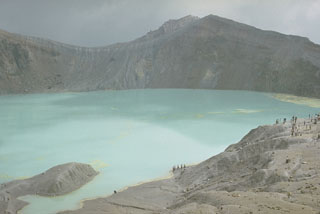Report on Kusatsu-Shiranesan (Japan) — February 1996
Bulletin of the Global Volcanism Network, vol. 21, no. 2 (February 1996)
Managing Editor: Richard Wunderman.
Kusatsu-Shiranesan (Japan) Minor hydrothermal ejection in Yu-gama crater
Please cite this report as:
Global Volcanism Program, 1996. Report on Kusatsu-Shiranesan (Japan) (Wunderman, R., ed.). Bulletin of the Global Volcanism Network, 21:2. Smithsonian Institution. https://doi.org/10.5479/si.GVP.BGVN199602-283120
Kusatsu-Shiranesan
Japan
36.618°N, 138.528°E; summit elev. 2165 m
All times are local (unless otherwise noted)
According to Kusatsu-Shirane Volcano Observatory (Tokyo Institute of Technology), at 1044 on 7 February geophysical changes occurred. A hydrophone submerged in Yu-gama pond recorded large amplitude sound waves and a meter registered water-level changes. Observers on 14 and 24 February saw discolored water near the NW part of the pond's surface and pieces of broken ice, 20-30 cm in size, along the shore. Therefore, on 7 February, a small magnitude ejection might have occurred at the pond. When a similar phenomenon was last observed, 6 January 1989, it was ascribed to hydrothermal activity.
Geological Summary. The Kusatsu-Shiranesan complex, located immediately north of Asama volcano, consists of a series of overlapping pyroclastic cones and three crater lakes. The andesitic-to-dacitic volcano was formed in three eruptive stages beginning in the early to mid-Pleistocene. The Pleistocene Oshi pyroclastic flow produced extensive welded tuffs and non-welded pumice that covers much of the E, S, and SW flanks. The latest eruptive stage began about 14,000 years ago. Historical eruptions have consisted of phreatic explosions from the acidic crater lakes or their margins. Fumaroles and hot springs that dot the flanks have strongly acidified many rivers draining from the volcano. The crater was the site of active sulfur mining for many years during the 19th and 20th centuries.
Information Contacts: Volcanological Division, Japan Meteorological Agency, 1-3-4 Ote-machi, Chiyoda-ku, Tokyo 100, Japan

